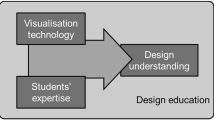Abstract
Learners have limited methods such as mind maps to gain an overview of the structure and key facts in their learning material. Knowledge Graphs (KGs) are a more powerful way of representing information on a learning topic since computers can also work with encoded knowledge and can help populate the graph with facts. However, visualizing the content of a KG to make it understandable and applicable for learning is a challenging task. We investigated the effect that different node representations of 3D Mixed Reality (MR) visualizations generated from KG data have on the learning behavior, memorability and user acceptance of such novel educational applications. For this, we developed an open-source software artifact that converts KGs about learning materials into three-dimensional networks which students can explore in a MR environment. The results of the study show that users prefer node visualizations in the graph that convey a visual identity in the form of images as opposed to merely displaying nodes as spheres. This preference is supported by the measured memorization, usability and technology acceptance values during the study. These insights help find an effective visualization of KGs for learning and understanding systematic information with their semantic interconnections in MR.
The research leading to these results has received funding from the German Federal Ministry of Education and Research (BMBF) through the project “Personalisierte Kompetenzentwicklung und hybrides KI-Mentoring” (tech4compKI) (grant no. 16DHB2213).
Access this chapter
Tax calculation will be finalised at checkout
Purchases are for personal use only
Similar content being viewed by others
References
Brooke, J.: SUS: a quick and dirty usability scale. In: Jordan, P.W., Thomas, B., Weerdmeester, B.A., McClelland, I.L. (eds.) Usability Evaluation in Industry, pp. 189–194. Taylor & Francis (1996). https://www.taylorfrancis.com/chapters/edit/10.1201/9781498710411-35/sus-quick-dirty-usability-scale-john-brooke
Buschel, W., Vogt, S., Dachselt, R.: Augmented reality graph visualizations. IEEE Comput. Graph. Appl. 39(3), 29–40 (2019). https://doi.org/10.1109/MCG.2019.2897927
Davis, F.: A Technology Acceptance Model for Empirically Testing New End-User Information Systems. Ph. D., Massachusetts Institute of Technology, Massachusetts (1985). http://hdl.handle.net/1721.1/15192
Drogemuller, A., Cunningham, A., Walsh, J.A., Ross, W., Thomas, B.H.: VRige: Exploring Social Network Interactions in Immersive Virtual Environments. https://doi.org/10.13140/RG.2.2.34201.67689
Fruchterman, T.M.J., Reingold, E.M.: Graph drawing by force-directed placement. Softw. Pract. Exp. 21(11), 1129–1164 (1991). https://doi.org/10.1002/spe.4380211102
Halpin, H., Zielinski, D.J., Brady, R., Kelly, G.: Exploring semantic social networks using virtual reality. In: Sheth, A., et al. (eds.) ISWC 2008. LNCS, vol. 5318, pp. 599–614. Springer, Heidelberg (2008). https://doi.org/10.1007/978-3-540-88564-1_38
Herman, I., Melancon, G., Marshall, M.S.: Graph visualization and navigation in information visualization: a survey. IEEE Trans. Visual Comput. Graph. 6(1), 24–43 (2000). https://doi.org/10.1109/2945.841119
Kortemeyer, G.: Virtual-reality graph visualization based on Fruchterman-Reingold using unity and SteamVR. Inf. Vis. 21(2), 143–152 (2022). https://doi.org/10.1177/14738716211060306
Pirnay-Dummer, P., Ifenthaler, D.: Reading guided by automated graphical representations: how model-based text visualizations facilitate learning in reading comprehension tasks. Instr. Sci. 39(6), 901–919 (2011). https://doi.org/10.1007/s11251-010-9153-2
Potnis, A.V., Durbha, S.S., Shinde, R.C., Talreja, P.V.: Towards visual exploration of semantically enriched remote sensing scene knowledge graphs (RSS-KGs). In: 2021 IEEE International Geoscience and Remote Sensing Symposium IGARSS, pp. 5783–5786. IEEE (2021). https://doi.org/10.1109/IGARSS47720.2021.9554836
Schreiber, G., Raimond, Y., Manola, F., Miller, E., McBride, B.: RDF 1.1 Resource Description Framework: Primer (2014)
Author information
Authors and Affiliations
Corresponding author
Editor information
Editors and Affiliations
Rights and permissions
Copyright information
© 2023 The Author(s), under exclusive license to Springer Nature Singapore Pte Ltd.
About this paper
Cite this paper
Hensen, B., Rechtmann, A., Neumann, A.T. (2023). Mixed Reality Learning Visualizations Using Knowledge Graphs. In: Xie, H., Lai, CL., Chen, W., Xu, G., Popescu, E. (eds) Advances in Web-Based Learning – ICWL 2023. ICWL 2023. Lecture Notes in Computer Science, vol 14409. Springer, Singapore. https://doi.org/10.1007/978-981-99-8385-8_12
Download citation
DOI: https://doi.org/10.1007/978-981-99-8385-8_12
Published:
Publisher Name: Springer, Singapore
Print ISBN: 978-981-99-8384-1
Online ISBN: 978-981-99-8385-8
eBook Packages: Computer ScienceComputer Science (R0)




